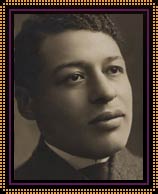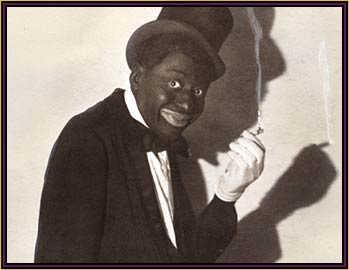 Pioneer of the Stage. W. C. Fields, star of the silent screen, called Bert Williams “the funniest man I ever saw and the saddest.” As a central figure on America’s vaudeville circuit, Williams sang, danced, and pantomimed in clubs, cabarets, and theaters across the country. Williams was one of, if not the most, famous African-American performers in the 1900s. In an age when the “white vaudeville stage did not welcome black performers,” Williams pioneered an important role for black performers who had so profoundly shaped the genre. With unfortunate regularity, he was often the only African American on stage. In the 1900s Williams was the toast of the cities he toured, and in 1904 he played a command performance in England for King Edward VII.
Pioneer of the Stage. W. C. Fields, star of the silent screen, called Bert Williams “the funniest man I ever saw and the saddest.” As a central figure on America’s vaudeville circuit, Williams sang, danced, and pantomimed in clubs, cabarets, and theaters across the country. Williams was one of, if not the most, famous African-American performers in the 1900s. In an age when the “white vaudeville stage did not welcome black performers,” Williams pioneered an important role for black performers who had so profoundly shaped the genre. With unfortunate regularity, he was often the only African American on stage. In the 1900s Williams was the toast of the cities he toured, and in 1904 he played a command performance in England for King Edward VII.
Facing Racism. Racial prejudice shaped Williams’ career. Unlike many other blackface performers, Williams did not play for laughs at the expense of other African Americans or black culture. Instead, he based his humor on universal situations in which any members of his audience might find themselves. In the style of vaudeville, Williams performed in blackface makeup like his white counterparts. Blackface worked like a double mask for him. It emphasized the difference between Williams, his fellow vaudevillians, and his white audiences.
Bert Williams
- "Abyssinia"
- "Bandanna Land"
- "In Dahomey"
- "Ziegfeld Follies of 1910"
- "Ziegfeld Follies of 1911"
- "Ziegfeld Follies of 1912"
- "Ziegfeld Follies of 1917"
- "Ziegfeld Follies of 1919"
- Eubie Blake
- Fanny Brice
- Eddie Cantor
- George Gershwin
- Noble Sissle
- Florenz Ziegfeld
Early Life. Williams was born in New Providence, Nassau, in the British West Indies, in 1874. He became a showman in 1893, when he joined Martin and Seig’s Mastodon Minstrels. While performing with the Minstrels he met African American song-and-dance man George Walker, and the two men teamed up. The twosome debuted in New York’s Casino Theatre in 1898 in a short-lived show, “The Gold Bug.” Their act consisted of songs, dance, and quick-paced patter that centered on Walker trying to convince the slower Williams to join him in get-rich-quick schemes. Williams and Walker’s popular act continued until Walker’s death in 1911.

Bert Williams in blackface.
Later Life. In 1920 Williams left the “Follies” and signed with another New York company, the Shuberts. On 21 February 1922 Williams collapsed onstage while touring with the production of “Under the Bamboo Tree.” Williams returned to New York City, where he died a month later.
Source: Excerpted from AMERICAN DECADES CD-ROM, Gale Research, © 1998 Gale Research. Reprinted by permission of The Gale Group.
Photo credits: Photofest and the New York Public Library

